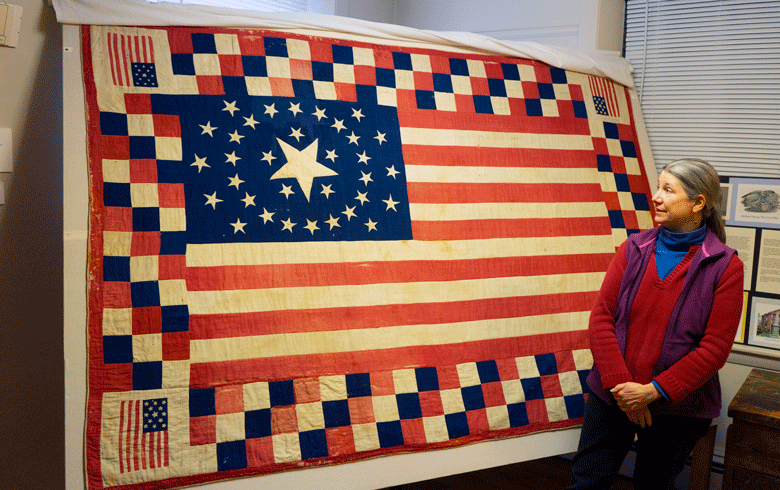Quilting has been a favorite pastime in Maine for centuries, first to provide warm coverings on cold winter nights, then rapidly evolving into a popular hobby for individuals and community groups. Women (and sometimes men) gathered for quilting bees to work on projects. Quilting bees also provided opportunities for socialization and catching up on the latest news.
Historians say quilts can reveal much about the time in which they were made. Laureen LaBar, chief curator of history and decorative arts at the Maine State Museum, said at least half of its collection of 180 quilts date to the late 1800s when textile mills were built to produce cotton, making it more affordable. Prior to the Civil War, Maine quilts were usually made from wool.
“Quilts reflect the times they were made,” she said. “If fabric is expensive, you don’t see a lot of quilts, and the quilts that you do see generally don’t have much variety in the number of fabrics used. With few exceptions, the earliest Maine quilts use only a few fabrics, because fabrics were expensive then.”
While many Civil War quilts were distributed to hospitals for bedding, others were sent to the battlefront to encourage the soldiers.
During the Civil War many women belonged to church or social groups which mobilized to produce socks, bandages, and quilts for military hospitals, LaBar said. Other groups made quilts for fundraisers.
LaBar is the author of Maine Quilts: 250 Years of Comfort and Community.
One Civil War quilt in the museum’s collection was made by Portland neighbors Carrie Davis and Cornelia Dow, with the help of friends, including several young women who attended Portland’s Home Institute. Others were from communities outside Portland.
“One hailed from Matanzas, Cuba and her presence in Portland reflects the thriving trade between Maine lumbermen and the sugar producers of the Caribbean islands,” said LaBar.
Davis and Dow distributed red and blue stars, along with white background fabric, to their friends. Each woman designed a block with popular sayings, quotations, and artwork, then backed, quilted, and bound each individual block before joining them together. Today that quilt style is referred to as a “potholder quilt” because each individual square resembles a potholder.
Many of the patriotic verses on the Portland quilt were authored by Henry Wadsworth Longfellow whose childhood home was near Cornelia Dow’s house. One can learn about the Civil War home front, women’s education in Maine, trade, and social networks from the blocks, LaBar said. Some of the squares featured newly published poetry, revealing that educated Maine women were aware of the literature of the day, she said.
BATTLEFIELD BEDDING
While many Civil War quilts were distributed to hospitals for bedding, others were sent to the battlefront to encourage the soldiers, called “inspirational” or “signature quilts.”
The Belfast Ladies Volunteer Aid Society made an inspirational quilt for Maine soldiers in 1864. It had a large American flag in the center. The quilt squares surrounding the flag were inscribed with names of the women who made the quilt, Bible verses, patriotic sayings, and poetry.
“This was a truly remarkable time period for both men and women from Belfast,” said Megan Pinette, Belfast Historical Society president and curator at the Belfast Museum. “Men were suddenly soldiers preparing for war and the women were setting to work sewing uniforms and quilts, baking, and canning in order to support the Union troops.”
The Belfast quilt was shipped to a military hospital in the nation’s capitol where it remained on display, with words of encouragement for the soldiers, for about a year, Pinette said. The hospital closed in 1865 and the whereabouts of the quilt was unknown for almost 150 years. Then in 2011, Pinette received a phone call from a Montana woman reporting she had discovered a rolled up flag quilt in her late mother’s home. The phrase “Belfast, Maine, June 17, 1864” was inscribed on the quilt.
It’s been speculated, said Pinette, that the quilt was given to the hospital’s chief surgeon Dr. D.W. Bliss when the hospital closed and it remained in his family for several generations. (Bliss was involved in the medical care of President James Garfield after he was shot.)
The quilt was once headed for the burn barrel but someone rescued and stored it in the Montana home. The woman shipped the quilt to the Belfast Historical Society and Museum where it remains on display.
“It’s very hard to describe the feeling that came over me as two museum volunteers began to unbox the 1864 quilt on the day it arrived from Montana,” Pinette said. “Just as they began to unfold it, I realized I had read about this very quilt in a recollection of Belfast during the Civil War written by Augusta Q. Frederick in 1917. At that moment, we all realized what a true treasure had just come to the museum.”
Another quilt offering a glimpse of the past is a crazy quilt made by former Bailey Island resident Mary Louise Orr in 1890. Crazy quilts, made of varying shapes and types of material, were decorated with beads, flowers, and other ornaments. It wasn’t uncommon for seamstresses to request autographs of famous people, handwritten with ink on strips of fabric or ribbon, to weave into crazy quilts.
According to the Maine State Museum’s website, Orr’s 10-year old daughter Ethel requested an autograph from advocate for the blind Helen Keller, who was also 10-years-old at the time. Keller responded that she had only learned to write with a pencil. However, the girls became lasting pen pals. The website says Keller wrote to Orr in square block style letters using a writing board with a groove as a guide.





